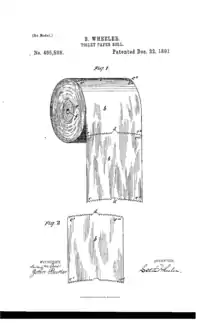Toilet paper orientation
Toilet paper has two possible orientations when the roll is parallel to both the wall and the floor: The toilet paper may hang over (in front of) or under (behind) the roll.
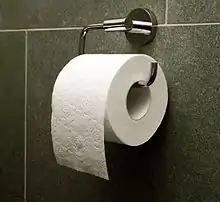
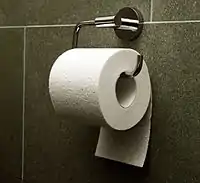
Some people hold strong opinions about which is better. Advice columnist Ann Landers said that the subject was the most controversial issue in her column's history and, at 15,000 letters in 1986, provoked the highest number of responses. Defenders of either position cite advantages ranging from aesthetics, hospitality, and cleanliness to paper conservation, ease of detaching sheets, and compatibility with pets. Some writers have proposed connections to age, sex, or political philosophy, and survey evidence has shown a correlation with socioeconomic status.[1]
Solutions where the views of household members differ include using separate dispensers or separate bathrooms and ignoring the issue. One man advocates a plan under which his country will standardize on a single forced orientation, and at least one inventor hopes to popularize a new kind of toilet roll holder which swivels from one orientation to the other.[2]
Context and relevance
In the article "Bathroom Politics: Introducing Students to Sociological Thinking from the Bottom Up",[3] Eastern Institute of Technology sociology professor Edgar Alan Burns describes some reasons toilet paper politics is worthy of examination. On the first day of Burns' introductory course in sociology, he asks his students, "Which way do you think a roll of toilet paper should hang?"[4] In the following fifty minutes, the students examine why they picked their answers, exploring the social construction of "rules and practices which they have never consciously thought about before".[5]
Burns' activity has been adopted by a social psychology course at the University of Notre Dame, where it is used to illustrate the principles of Berger and Luckmann's 1966 classic The Social Construction of Reality.[6]
Christopher Peterson, a professor of psychology at the University of Michigan, classifies the choice of toilet paper orientation under "tastes, preferences, and interests" as opposed to either values or "attitudes, traits, norms, and needs". Other personal interests include one's favorite cola or baseball team. Interests are an important part of identity; one expects and prefers that different people have different interests, which serves one's "sense of uniqueness". Differences in interests usually lead at most to teasing and gentle chiding. For most people, interests do not cause the serious divisions caused by conflicts of values; a possible exception is what Peterson calls "the 'get a life' folks among us" who elevate interests into moral issues.[7]
Morton Ann Gernsbacher, a professor of psychology at the University of Wisconsin–Madison, compares the orientation of toilet paper to the orientation of cutlery in a dishwasher, the choice of which drawer in a chest of drawers to place one's socks, and the order of shampooing one's hair and lathering one's body in the shower. In each choice, there is a prototypical solution chosen by the majority, and it is tempting to offer simplistic explanations of how the minority must be different. She warns that neuroimaging experiments—which as of 2007 were beginning to probe behaviors from mental rotation and facial expressions to grocery shopping and tickling—must strive to avoid such cultural bias and stereotypes.[8]
In his book Conversational Capital, Bertrand Cesvet gives toilet paper placement as an example of ritualized behavior—one of the ways designers and marketers can create a memorable experience around a product that leads to word-of-mouth momentum. Cesvet's other examples include shaking a box of Tic Tacs and dissecting Oreo cookies.[9]
Broadcaster Jim Bohannon has said that such issues are good for talk radio: "It is an interactive medium, a certain kind of clash, it doesn't have to be a violent clash, but at least a disagreement would certainly be at the top of the list. It has to be something that's of general interest."[10]
Arguments

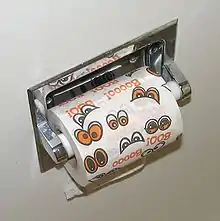
The main reasons given by people to explain why they hang their toilet paper a given way are ease of grabbing and habit.[11] Some particular advantages cited for each orientation include:
- Over reduces the risk of accidentally brushing the wall or cabinet with one's knuckles, potentially transferring grime and germs.[12]
- Over makes it easier to visually locate and to grasp the loose end.[13]
- Over gives hotels, cruise ships, office buildings, public places and homeowners with guest bathrooms the option to fold over the last sheet to show that the room has been cleaned.[14]
- Over is generally the intended direction of viewing for the manufacturer's branding, so patterned toilet paper looks better this way.[15]
- Under provides a tidier appearance, in that the loose end can be more hidden from view.[16][17]
- Under reduces the risk of a toddler or a house pet such as a cat unrolling the toilet paper when batting at the roll.[18]
- Under in a recreational vehicle may reduce unrolling during driving.[19]
Partisans have claimed that each method makes it easier to tear the toilet paper on a perforated sheet boundary.[20] (A traveller from the U.S. to China in 1991 noted a different setup: non-perforated paper with a metal cutter above the roll, which obliges the over direction.)[21]
It is unclear if one orientation is more economical than the other. The Centralian Advocate attributes a claim that over saves on paper usage to Planet Green.[22]
In the academic field of evaluation, Michael Scriven writes that the question of the correct way to insert toilet paper is a "one-item aptitude test" for measuring one's evaluation skills. These skills include the evaluative attitude, practical logical analysis, empathy, teaching, and being a quick study. To prove one's competence, one may either derive the "one right answer" or prove that the test is or is not culturally biased.[23]
In surveys of American consumers and of bath and kitchen specialists, 60-70% of respondents prefer over.[24]
Preferences
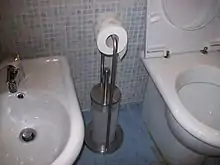
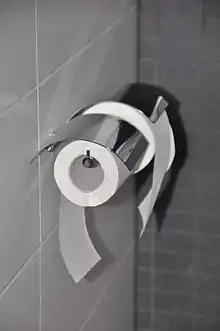
Survey results
The question "Do you prefer that your toilet tissue unwinds over or under the spool?" is featured on the cover of Barry Sinrod and Mel Poretz's 1989 book The First Really Important Survey of American Habits. The overall result: 68 percent chose over.[25]
In Bernice Kanner's 1995 book Are You Normal?, 53 percent of survey respondents prefer over, while "a fourth" prefer under and 8 percent do not know or care.[26]
Sitting Pretty: The History of the Toilet, a travelling exhibition that tours Canadian museums, asks visitors to register their preferred roll direction. When the exhibition reached Huntsville, Ontario, in June 2001, 13,000 visitors had taken the survey, with 67 percent preferring over.[27] At the Saint Boniface Museum in Winnipeg in February 2005, a voting machine registered 5,831 over versus 5,679 under, or 51 percent over. Saint Boniface's director noted, "I think there's been some cheating, though."[28]
Georgia-Pacific commissioned a survey of Americans' bathroom habits in 1993 to launch its new Quilted Northern brand, and more surveys followed:[29]
- 1993 Practices and Preferences of Toilet Paper Users: 73 percent over out of 1,200 respondents. The press release claims, "A first-of-its-kind survey has settled, once and for all, the great toilet paper debate."[30]
- 1994 Toilet Paper Report: 59 percent over,[31] out of 1,000 respondents; conducted by KRC Research and Consulting[32]
- 1995 Bathroom Tissue Report: 59 percent over versus 29 percent under,[33] out of 1,000 respondents; conducted by KRC Research and Consulting[31]
- 2001 Bathroom Confidential: 63 percent over out of 1,001 respondents; conducted by Impulse Research[34]
- 2004 Bathroom Confidential: 72 percent over[35]
In 1993, American Standard Brands conducted a poll of "designers, contractors, dealers, distributors and other bath and kitchen reps"[36] at the Kitchen/Bath Industry Show & Conference in Atlanta. The question: "What is the correct and only way to hang the toilet paper – under or over?"[37] Over won 59 percent of the vote, 1,826 to 1,256 respondents.[36] American Standard spokeswoman Nora Monroe observed, "The bathroom is a territorial place. You'd be surprised how many people have definite opinions on this issue."[38] In 2008, American Standard commissioned the 2008 Bathroom Habits Survey, a more traditional format conducted by Opinion Research Corporation with 1,001 respondents. This time, "three-quarters" answered over.[39]
In 1995, a survey by Scott Paper Company's "Cottonelle College of Freshness Knowledge" had "most Americans over 50" preferring over.[40] In another Cottonelle survey in 1999, 68 percent of respondents preferred over to 25 percent under.[41]
In a survey of 1,000 Americans, Cottonelle found that "overs" are more likely than "unders" to notice a roll's direction (74 percent), to be annoyed when the direction is incorrect (24 percent), and to have flipped the direction at a friend's home (27 percent).[42]
According to W. C. Privy's Original Bathroom Companion, Number 2, "By more than 4 to 1, older folks prefer to have their toilet paper dispense over the front."[43] The same claim is made by James Buckley's The Bathroom Companion for people older than 50.[44]
In one local election in Saskatoon, Saskatchewan, new voting machines were given a trial run by asking the question, "Are you in favor of toilet paper in all public washrooms being installed with the loose end coming up and over the front of the roll?" The answer was yes: 768 to 196, or 80 percent over. It was thought to be a question "which carried no political association".[45] Yet one teenager's science project at the Southern Appalachian Science and Engineering Fair, and a favorite of the fair's coordinator, was a survey concluding that liberals roll over while conservatives roll under.[46]
Noted preferences
Advice columnist Ann Landers (Eppie Lederer) was once asked which way toilet paper should hang. She answered under, prompting thousands of letters in protest; she then recommended over, prompting thousands more.[47] She reflected that the 15,000 letters made toilet paper the most controversial issue in her column's 31-year history,[48] wondering, "With so many problems in the world, why were thousands of people making an issue of tissue?"[47]
In November 1986, Landers told the Canadian Commercial Travellers Association that "Fine-quality toilet paper has designs that are right side up" in the over position.[48] In 1996, she explained the issue on The Oprah Winfrey Show, where 68 percent of the studio audience favored over; Oprah suggested that under uses more paper.[49] In 1998, she wrote that the issue "seems destined to go on forever", insisting, "In spite of the fact that an overwhelming number of people prefer the roll hung so that the paper comes over the top, I still prefer to have the paper hanging close to the wall."[45] On the day of her last column in 2002, Landers wrote, "P.S. The toilet paper hangs over the top."[50] Her published commentary on the issue has even continued after her death. 2005 saw the premiere of a one-woman play written by David Rambo: a character study of Ann Landers titled The Lady with All the Answers. Toilet paper comes up once again, and the actress surveys the audience for their opinions.[51]
In his article in Teaching Sociology, Burns writes that the toilet paper hanging exercise is valuable in part because "[the] subject matter is familiar to everybody; everyone is an expert, and everyone has an opinion."[52] Many entertainers, celebrities and businesspeople have publicized their opinion on the topic.
Social consequences
Toilet paper orientation is sometimes mentioned as a hurdle for married couples.[54] The issue may also arise in businesses and public places.[55]
Even at the Amundsen–Scott Research Station at the South Pole, complaints have been raised over which way to install toilet paper. During the six-month-long polar night, a few dozen residents are stuck living together, and while many of the headaches of modern life are far away, food and hygiene are not. Despite the challenges posed by the hostile Antarctic climate, "It is in the more mundane trials of everyday life that personality clashes are revealed."[56]
Solutions
Some of the proposed solutions to this problem involve more or better technology, while others concentrate on human behavior.
Mechanical
The Tilt-A-Roll is a swiveling toilet paper dispenser invented by Curtis Batts in 1996, a Dallas-native industrial engineer.[57] His patents on the invention, summarize its design as "An adjustable angle coupling secures the yoke to the mounting assembly and permits rotation of the yoke about an axis directed orthogonally through the spindle such that the paper roll can be oriented to unroll paper either from over or from under the roll as desired."[58] An inventor named Rocky Hutson demonstrated a similar device he called the T.P. Swivel to the producers of the television program PitchMen in late 2009. [59]
Another solution is to install two toilet paper dispensers. A reader of the Annie's Mailbox column recommends using a holder large enough to fit two rolls, noting that the roll mounted over is more popular. Another reader sidesteps the issue by foregoing the holder, instead piling five or six rolls in a big wicker basket.[60] Even using separate bathrooms can help.[61] Other solutions include vertical holders.
Behavioral
Toilet paper orientation has been used rhetorically as the ultimate issue that government has no business dictating, in letters to the editor protesting the regulation of noise pollution[62] and stricter requirements to get a divorce.[63] In 2006, protesting New Hampshire's ban on smoking in restaurants and bars, representative Ralph Boehm (R–Litchfield) asked "Will we soon be told which direction the toilet paper must hang from the roll?"[64]
David O'Connor's 2005 book Henderson's House Rules: The Official Guide to Replacing the Toilet Paper and Other Domestic Topics of Great Dispute aims to solve disagreements with a minimum of debate or compromise by offering authoritative, reasonable rules.[65] The "House Rule" for toilet paper is over and out, and a full page is dedicated to a diagram of this orientation. But O'Connor writes that "if a female household member has a strong preference for the toilet paper to hang over and in, against the wall, that preference prevails. It is admittedly an odd preference, but women use toilet paper far more often than men—hence the rule."[66]
Notes and references
Notes
- For pros and cons, including RVs and cats, see Arguments; for celebrities and experts, including Ann Landers, see Noted preferences; for theories, see Themes.
- The enthusiast, Bill Jarrett, and the inventor, Curtis Batts, are described in Solutions.
- Burns 2003.
- Burns 2003, p. 111.
- Burns 2003, p. 113.
- Collett 2008.
- Peterson 2006, pp. 173–175.
- Gernsbacher 2007.
- Cesvet, Babinski & Alper 2008, p. 68.
- Voice of America 2004.
- Progressive Grocer 2010.
- Ode 2010: "The Kimberly-Clark company cites three advantages for rolling over: perforation control, viewing advantage and wall avoidance."; Garton 2005; Jarski & Jarski 2007.
- Ode 2010; Elliott 2006
- Lind 1992; "The Grand Princess cruise ship replaces its toilet paper with the leading edge over the front, so that it can be folded as is done in five-star hotels. (Yes, someone really did ask this question.)" (Carpenter 1999); Rosencrans 1998; Garton 2005.
- Grant 1991b; Garton 2005; Mitchell & Sugar 2005a; Jarski & Jarski 2007.
- Jarski & Jarski 2007
- "Toilet Paper Orientation Re: Brandweek 2009". Retrieved 21 January 2015.
- Darbo 2007; Garton 2005; O'Connor 2005, p. 63.
- Nerbas 2009.
- Ode 2010; Weingarten 2008; Keeran 1993.
- Downey & Harrison 1993.
- McNatt 2010.
- Scriven 1991, "Evaluation Thesaurus", pp. 151–153, especially p. 153 for the quotations.
- Yenisey, Zeynep (5 April 2016). "What the Direction Your Toilet Paper Hangs Says About You According to Science: Under or over?". Maxim. Retrieved 2 April 2020.
- Rubin 1989.
- Kanner 1995, pp. 56, 120.
- Ladan 2001.
- Nestruck 2005.
- The 1996 report, which may not have contained this question, was the fourth annual report: (McCarthey 1996)
- PR Newswire 1993.
- Ortega 1995.
- Ciancio 1994.
- Ciancio 1995.
- Dickson 2001.
- Ebenkamp 2004; Pierson 2004.
- Toronto Star staff and news services 1993.
- Stark 1993.
- Clark 1993.
- American Standard Press 2008.
- Harden 1995.
- Henry 1999.
- PR Newswire 2010.
- Barrett & Mingo 2003, p. 400.
- Buckley 2005, p. 106.
- Landers 1998.
- Keim 1997.
- Marelius 1987.
- Toronto Star 1986.
- The Oprah Winfrey Show 1996.
- Landers 2002.
- Welsh 2005; Rawson 2008.
- Burns 2003, p. 116.
- Jenny Che (17–19 March 2015). "This 124-Year-Old Patent Reveals The Right Way To Use Toilet Paper". HuffPost. Retrieved 2 May 2015.
- Wolf 1999, pp. 74–75; Hogan & Hogan 2000, p. 200.
- Lui 2009; Grant 1991a.
- Daily Express 1999, p. 39.
- Floyd 1999.
- US 5588615 and US 5690302
- Zayas 2009.
- Mitchell & Sugar 2005b.
- Arkins 1994; Jarski & Jarski 2007.
- Ratzlaff 2009.
- Wuthrich 2006.
- Saunders 2006.
- O'Connor 2005, pp. 2–3.
- O'Connor 2005, pp. 63–64; Davis 2006.
References
- Answer Fella (January 2007), "Famous Birthdays, Girlfriend Advice & a Brief History of Toilet Paper", Esquire, 147 (1), p. 52, retrieved 11 July 2010
- Arkins, Diane C. (7 October 1994), "Consider Fallout of New Bath", Chicago Sun-Times, p. 22N, Factiva chi0000020011028dqa700wzz
- Barrett, Erin; Mingo, Jack, eds. (December 2003), W. C. Privy's Original Bathroom Companion, Number 2, St. Martin's Press, ISBN 0-312-31580-5
- Blow, Steve (7 November 1990), "This survey asks questions we care about", The Dallas Morning News, p. HOME FINAL 23A, Factiva dal0000020011207dmb702ey9
- Braun, Jenifer D. (28 August 2003), "Makeover host trades roles", The Star-Ledger, p. 71, Factiva NSL0000020030828dz8s0008a
- Breithaupt, Tim (2003), 10 Steps to Sales Success, AMACOM, ISBN 0-8144-7165-X
- Brewer, Jack (1 December 2002), "Among Friends: There's always time to change", Houston Chronicle, p. Lifestyle 8, Factiva hou0000020021203dyc10005u
- Buckley, James (2005), The Bathroom Companion: A Collection of Facts About the Most-Used Room in the House, Quirk Books, ISBN 1-59474-028-3
- Burns, Edgar Alan (January 2003). "Bathroom Politics: Introducing Students to Sociological Thinking from the Bottom Up". Teaching Sociology. 31 (1): 110–118. doi:10.2307/3211429. JSTOR 3211429.
- Cantor, Paul A. (2003), Gilligan Unbound: Pop Culture in the Age of Globalization, Rowman & Littlefield, ISBN 0-7425-0779-3
- Cesvet, Bertrand; Babinski, Tony; Alper, Eric (2008), Conversational Capital: How to Create Stuff People Love to Talk About, Pearson Education, ISBN 0-13-714550-0
- Ciancio, Dan (1 February 1994), New study flushes out facts on the American bathroom (press release), PR Newswire, Factiva prn0000020011030dq210061e
- Ciancio, Dan (13 February 1995), "Potty Break", Rocky Mountain News, Factiva rmtn000020011026dr2d005jw
- Clark, Gary A. (21 June 1993), "Monday Memo", St. Louis Post-Dispatch, p. 9, Factiva SLMO000020040622dp6l00hkc
- Collett, Jessica (Spring 2008), "Class 4: Social Construction of Reality", Notre Dame OpenCourseWare, archived from the original on 29 June 2010, retrieved 12 July 2010
- Darbo, Paul (April 2007), "This Way In: The Sound and the Fury: ELSEWHERE IN THE BIN (letters to the editor)", Esquire, 147, p. 22
- Davis, Rich (14 February 2006), "'House Rules' Aims at Harmony", The Evansville Courier, p. D5, Factiva EVVL000020060216e22e0004u
- Dickson, Gunna (3 July 2001), New Products – Clean All Over, Reuters, Factiva lba0000020010912dx730069x
- Downey, Maureen; Harrison, Bette (27 June 1993), "Peach buzz talk of our town", Atlanta Journal and Constitution, p. D/2, Factiva atjc000020011031dp6r00w44
- Ebenkamp, Becky (19 January 2004), "Out of the Box", Brandweek, Factiva ADMW000020040202e01j0002m
- Elger, Dietmar; Solaro, Elizabeth M. (2010), Gerhard Richter: A Life in Painting, University of Chicago Press, ISBN 0-226-20323-9
- Elliott, Carson (11 June 2006), "The proper thing: Position plates so that meat is closest to diner, unless dishes display pictures", Augusta Chronicle, p. G02, Factiva AGCR000020060809e26b00004
- FitzSimons, Peter (2009), How Hemlines Predict the Economy: Explanations, Rationalizations, and Theories on Everything, Skyhorse Publishing, ISBN 978-1-60239-311-0
- Flatow, Ira (8 August 1997), "Left handedness and Meteor Showers", Talk of the Nation, Factiva totn000020011008dt88000by
- Floyd, Jacquielynn (29 June 1999), "Inventor rolls out solution to toilet paper war", The Dallas Morning News, p. 15A, Factiva dal0000020010829dv6t005qf
- Freiberg, Kevin; Freiberg, Jackie (1998), Nuts!: Southwest Airlines' crazy recipe for business and personal success (1st paperback ed.), Broadway Books, ISBN 0-7679-0184-3
- Galupo, Scott (16 February 2005), "Four troubadours trade tunes, tales", The Washington Times, p. B05, Factiva WATI000020050216e12g0000t
- Garton, Nicole (8 January 2005), "Over or under? The great toilet paper debate continues", Tulsa World, p. D10, Factiva TUL0000020050111e1180000y
- Gernsbacher, Morton Ann (March 2007), "Presidential Column: Neural Diversity", Observer, Association for Psychological Science, 20 (3): 5, 15, retrieved 28 March 2013
- Godfrey, Linda S. (2006), Mark Sceurman and Mark Moran (ed.), Weird Michigan: Your Travel Guide to Michigan's Local Legends and Best Kept Secrets, Sterling, ISBN 1-4027-3907-9
- Grant, Michael (16 July 1991), "Paper chase unravels at 30,000 feet", The San Diego Union-Tribune, p. C-1, Factiva SDU0000020070627dn7g002uk
- Grant, Michael (1 September 1991), "Toilet paper theorist is on a roll, but issue is still under scrutiny", The San Diego Union-Tribune, p. D-1, Factiva SDU0000020070627dn91007fo
- Greenberg, Steve (2007), Gadget Nation: A Journey Through the Eccentric World of Invention, Sterling, ISBN 978-1-4027-3686-5
- Grimes, David (15 February 1999), "When tissue is an issue", Sarasota Herald-Tribune, p. 1E, Factiva ssta000020010829dv2f003ir, retrieved 11 October 2013
- Hage, Joe (2010), "Gerhard Richter » Art » Atlas » Atlas Sheet 15 » Associated Paintings » Toilet Paper » 75-3", gerhard-richter.com, retrieved 12 July 2010
- Harden, Hike (30 July 1995), "Like these ideas? OK, then start your own column", The Columbus Dispatch, p. 01I, Factiva clmb000020011024dr7u00d2h
- Harris, David (1 January 2010), "Letters to the Editor: One way or another, just let it roll", The Australian, p. 19, Factiva AUSTLN0020091231e6110002o
- Henry, Bonnie (1 August 1999), "The key role of toilet paper has columnist's eyes rolling", The Arizona Daily Star, p. 3E, Factiva tucs000020010830dv81006wg
- Hogan, Eve Eschner; Hogan, Steve (2000), Intellectual Foreplay: Questions for Lovers and Lovers-To-Be, Hunter House
- Hunt, Don; Edwards, Brian (28 April 2000), "Toilet Seat Creates Flush of Excitement", Chicago Tribune, retrieved 3 July 2010
- Ichikawa, Anne (June–July 2004), "Celebrity Bathroom", Elle Girl, p. 64
- Ichikawa, Anne (March 2005), "Celebrity Bathroom", Elle Girl, p. 106
- Jarski, Rosemarie; Jarski, Milena (2007), How to Do Everything!, Globe Pequot, p. 143, ISBN 978-1-84537-415-0
- Kanner, Bernice (15 September 1995), Are You Normal?: Do You Behave Like Everyone Else?, St. Martin's Paperbacks, ISBN 0-312-95592-8
- Keeran, James (30 December 1993), "Professor Jaggi // Rocket Scientist", The Pantagraph, p. C1, Factiva blm0000020011031dpcu00n58
- Keim, David (7 April 1997), "Science fair has 301 entries from 40 schools", The Knoxville News-Sentinel, p. A4, Factiva kxvl000020011007dt47006av
- Kimberly-Clark (27 January 2010), How Does America Roll? Cottonelle Brand Teams With Tori and Dean to End the Age-Old Debate: Over or Under? (press release), PR Newswire, Factiva
- Ladan, Mark (20 March 2001), "New exhibit from Guelph lifts the lid on toilet history", Toronto Star, p. A04, Factiva tor0000020010713dx6k00ldj
- Landers, Ann (24 April 1992), "Which way do you hang the roll? A poll", The Dallas Morning News, p. 2c, Factiva dal0000020011206do4o00fma
- Landers, Ann (8 February 1997), "Ann Landers", The Washington Post, p. B09, Factiva wp00000020020504dt2800ipf
- Landers, Ann (7 January 1998), "'Illegitimate daughter' harassing you could be a dangerous weirdo", St. Louis Post-Dispatch, p. E2, Factiva SLMO000020040607du17004nd
- Landers, Ann (27 July 2002), Mary K. Nolan (ed.), "It's been an interesting 47 years", The Hamilton Spectator, p. A01, Factiva hmsp000020030501dy7r000xe
- Lawrence, Keith (20 November 1999), "Here's another tidbit you can use to win an argument", Messenger-Inquirer, Factiva krtbn00020010828dvbk0256f
- Lind, Angus (17 July 1992), "In a spin over tissue issue", Times-Picayune, p. E1, Factiva notp000020011107do7h00dum
- Lipman, Joanne (17 August 1987), "Censored Scenes: Why You Rarely See Some Things in Television Ads", The Wall Street Journal, Factiva j000000020011118dj8h00kz8
- Loftin, Josh (22 June 2004), "Hiatt warms up crowd slowly", Deseret Morning News, p. C04, Factiva DN00000020040622e06m0000w
- Lui, John (13 April 2009), "Hip night owl", The Straits Times, Factiva STIMES0020090412e54d00022
- Luna, Aaron (29 August 2009), "Toilet Paper Debate Finally Solved: Paper from the top or bottom, now you can have it both ways.", nbc11news.com, KKCO, retrieved 23 August 2010
- Magill, Frank Northen, ed. (1993), "All in the Family Introduces a New Style of Television Comedy", Great Events from History II: Arts and Culture Series, 5, Pasadena, California: Salem Press, pp. 2234–2238, ISBN 0-89356-812-0
- Marelius, John (18 February 1987), "Ann Landers' world has changed in 31 years", The San Diego Union-Tribune, p. D-3, Factiva SDU0000020070707dj2i00mgk
- Mark Wolf Scripps Howard News Service (1 January 1990), "Little habits tell a lot about us all", St. Louis Post-Dispatch, p. EVERYDAY MAGAZINE 1D, Factiva SLMO000020040626dm1101jgj
- Matsushita, Elaine (12 October 2008), "Looking for Matt Wertz? Check in the butler's pantry", Chicago Tribune, Factiva KRTTB00020081012e4ac00046
- Matsushita, Elaine (22 March 2009), "Daren Kagasoff reveals what's really in his closet (think Imelda Marcos)", Chicago Tribune, Factiva KRTTB00020090322e53m00037
- McCarthey, Tom (3 March 1996), "Unraveling Toilet Trivia", The Salt Lake Tribune, p. Travel H1, Factiva sltr000020011015ds33006we
- McNatt, Cindy (25 April 2010), "Small ways to go GREEN", The Orange County Register, Factiva OCR0000020100503e64p0002t,
Planet Green says that if you hang your toilet paper roll so the paper comes out over the top, not from under, you'll save on toilet paper.
- Miller, Michael (28 May 1999), "Glowing with inspiration, perspiration", Pittsburgh Business Times, retrieved 3 July 2010
- Mitchell, Kathy; Sugar, Marcy (19 April 2005a), "Annie's Mailbox: Friend's abuse should be reported" (PDF), Vernon Daily Record, p. 6, retrieved 3 July 2010
- Mitchell, Kathy; Sugar, Marcy (13 September 2005b), "Annie's Mailbox: Ask phone company to block prank calls", The Gazette (Montreal), p. E8, Factiva MTLG000020050915e19d0000c
- Ms Maud (23 November 2002), "Toilet Training", The Press, p. 2, Factiva thepre0020021125dybn000xi
- Nalebuff, Barry; Ayres, Ian (2006), Why Not?: How to Use Everyday Ingenuity to Solve Problems Big And Small, Harvard Business Press
- Nerbas, Reena (4 October 2009), "Pesky glue: Peanut butter to the rescue", Winnipeg Free Press, p. D2, Factiva WFP0000020091004e5a40000h
- Nestruck, J. Kelly (1 February 2005), "In loo of usual exhibits", National Post, p. AL5, Factiva FINP000020050201e1210002l
- Newman, Paul (October 2000), "INVENTOR PROFILE: Curtis Batts, Inventor of the Tilt-A-Roll", The Online Inventor, archived from the original on 9 February 2011, retrieved 3 July 2010
- O'Connor, David (2 May 2005), Henderson's House Rules: The Official Guide to Replacing the Toilet Paper and Other Domestic Topics of Great Dispute, East Quincy Publishing, ISBN 0-9764078-0-9
- Ode, Kim (16 March 2010), "psst...", Star-Tribune, p. 1E, Factiva MSP0000020100322e63g0006s
- Oldenburg, Don (12 October 1989), "Little Did You Know ...", The Washington Post, p. STYLE c05, Factiva wp00000020011117dlac01bs2
- Orr, Karin (17 September 1995), "We meet face to face, but see only a face", The Grand Rapids Press, p. j1, Factiva grpr000020011025dr9h00ajp
- Ortega, Mary (26 January 1995), Caught in the act: America's bathroom detectives (press release), PR Newswire, Factiva prn0000020011026dr1q005hj
- Paul, John (2006), ""Flushing" Out Sociology: Using the Urinal Game and other Bathroom Customs to Teach the Sociological Perspective" (PDF), Electronic Journal of Sociology, archived from the original (PDF) on 14 July 2010, retrieved 11 July 2010
- Peterson, Christopher (2006), A Primer in Positive Psychology, Oxford: Oxford University Press
- Pierson, Amy (13 January 2004), "Dick Clark Helps Usher in a New Year of Softness (press release)", Market Wire, Factiva ITWR000020040113e01d00001
- Poretz, Mel; Sinrod, Barry (19 July 1989), The First Really Important Survey of American Habits, Price Stern Sloan, ISBN 0-8431-2735-X
- Rademacher, Tom (11 April 2005), Toilet tissue collector is a real roll player, Associated Press Newswires, Factiva APRS000020050411e14b00c1j
- Ratzlaff, Brian (28 June 2009), "Is 'Nanny State' Neutering Us?", The Modesto Bee, p. A11, Factiva MBEE000020090630e56s0000b
- Rawson, Christopher (24 November 2008), "Sage advice:Don't miss Ruoti playing Ann Landers", Pittsburgh Post-Gazette, p. E-1, Factiva PPGZ000020081124e4bo0001v
- Rosencrans, Joyce (7 November 1998), "To fold or not to fold/ guest-bathroom tissue", The Cincinnati Post, p. 1C, Factiva cinp000020010916dub700mw1
- Rubin, Neal (28 September 1989), "From socks to toilet paper roll, answers unfold in U.S. survey", Toronto Star, p. LIFE L2, Factiva TOR0000020080325dl9s019zs
- Russell, Jan Jarboe (2006), "Can You Take a Hint?", Texas Monthly on... Texas Women, Emmis Publishing, p. 84, ISBN 0-292-71327-4
- Saunders, Anne (21 March 2006), Restaurant smoking ban passes in the House, Associated Press Newswires, Factiva APRS000020060321e23l002xm
- Scriven, Michael (1991), Evaluation Thesaurus (4th ed.), SAGE Publications, ISBN 0-8039-4363-6
- Stark, Judy (27 June 1993), "They must be flushed", St. Petersburg Times, p. AT HOME, 1, Factiva stpt000020011101dp6r00yb8
- Stovall, Waltrina (1 August 1997), "Looks like a good idea on toilet paper: Roll-holder inventor, others vie for spots on shopping channel", The Dallas Morning News, Factiva dal0000020011006dt81013qz
- Tighe, Mike (30 April 2008), "Incorrect Twist-Ties Put Some in Knots", The Palm Beach Post, p. 3, Factiva PMBP000020080501e44u00013
- Toronto Star staff and news services (15 June 1993), "Over beats under in toilet paper poll", Toronto Star, p. LIFE, B1, Factiva TOR0000020080312dp6f00bo2
- Walsh, Michael (8 August 1999), "What's new: Four recent additions to product list for homes promising", Patriot-News, p. H01, Factiva pathar0020010827dv8800j36
- Weingarten, Gene (4 November 2008), "Chatological Humor", The Washington Post, Factiva WPCOM00020081105e4b40000a
- Welsh, Anne Marie (13 August 2005), "'Lady' a better read in newsprint", The San Diego Union-Tribune, p. E-1, Factiva SDU0000020050815e18d00031, retrieved 12 July 2010
- Widdicombe, Ben (8 June 2004), "Butler Servers Up More Dish on Diana", Daily News, New York, p. 38, Factiva NYDN000020040608e0680005m
- Wizda, Sharyn (19 March 1990), "Personalities", The Washington Post, p. c03, Factiva wp00000020011116dm3j00bd9
- Wolf, Sharyn (1999), So You Want to Get Married: Guerrilla Tactics for Turning a Date into a Mate, Plume
- Wuthrich, John F. (26 January 2006), "Who elected these freaks?", The Salt Lake Tribune, p. A10, Factiva SLTR000020060127e21q0001a
- Wyman, Pat (2001), Three Keys to Self-Understanding: An Innovative and Effective Combination of the Myers-Briggs Type Indicator, the Enneagram, and Inner-Child Healing, Center for Applications of Psychological Type, ISBN 0-935652-57-4
- Yeld, John (31 March 2010), "SMS feedback – March 31, 2010", Cape Argus, Factiva MEWCAP0020100401e63v00011,
A British loo paper manufacturer investigated whether it was more economical to run loo paper over the top or draw it from below. From below was the verdict.
- Zayas, Alexandra (5 November 2009), "Inventors gather in Ybor City to pitch for Pitchmen", St. Petersburg Times, archived from the original on 9 December 2009, retrieved 11 October 2013
- "American Standard Bathroom Habits Survey Shows We're Multitasking, Even in the Bath (press release)", American Standard Press, 20 August 2008, retrieved 11 October 2013
- "The Self-styled Publisher", Brandweek, 4 May 2009, Factiva ADMW000020090604e5540002j
- "Dingo – Fisherman's tale", Centralian Advocate, p. 6, 7 May 2002, Factiva cadvoc0020021123dy57002nt,
A particularly fascinating response came from a reader who found a university in the US conducted a study into the most economical toilet paper use. The six-month study found that when the toilet paper came over the front of the roll less was used than if the paper was pulled from the back.
- "Manners Column", The Courier-Mail, p. 18, 1 November 2000, Factiva coumai0020010805dwb10037p
- "Wines from the Fourth Estate", The Daily Examiner, p. 26, 23 May 2009, Factiva APNDEG0020090522e55n000b7
- "At long last, I can escape from my Polar prison", Daily Express, pp. 38–39, 14 October 1999, Factiva theexp0020010826dvae0066w
- "StartUP: The Last Word: No detail missed by Southwest exec", Dayton Daily News, p. 1A, 19 June 1996, Factiva ddnw000020011017ds6j000tc
- "Pandora's Portfolio", Fund Action, Euromoney Institutional Investor, 2 March 2009, Factiva FUNDAC0020090316e52r00007
- "Interview: Ann Landers; Ann Landers discusses her life, her column and her new book, 'Wake Up and Smell the Coffee!'", The Oprah Winfrey Show, 6 June 1996, Factiva OPRH000020070817ds66000bj
- Quilted Northern survey answers age-old question (press release), PR Newswire, 21 May 1993
- Kimberly-Clark (8 March 2010), America Sides With Tori Spelling, Rolls Over, PR Newswire, Factiva PRN0000020100308e638001jl
- "Cottonelle on a Roll With Consumers", Progressive Grocer, 31 January 2010, Factiva PRGR000020100202e61v0000s
- "Hang toilet paper over top of roll, Ann Landers says", Toronto Star, p. A4, 19 November 1986, Factiva TOR0000020080607dibj01g0q
- "TTA/Talk Radio", Voice of America Press Releases and Documents, 2 March 2004, Factiva VOA0000020040303e0320001j
Further reading
- "For Your Information", The News & Observer, p. C1, 4 October 1993, Factiva rnob000020011101dpa400p2p
- References "a Reader's Digest poll". Primary source unclear.
- Brody, Ed (2002), Spinning Tales, Weaving Hope: Stories, Storytelling, and Activities for Peace, Justice and the Environment, New Society Publishers, p. 158
- Cameron, W. Bruce (2004), How to Remodel a Man: Tips and Techniques on Accomplishing Something You Know Is Impossible But Want to Try Anyway, Macmillan, p. 185
- Carpenter, Richard P. (28 March 1999), "It's swimming vs. snoozing", The Boston Globe, p. M4, Factiva bstngb0020010825dv3s00asy
- Freeman, Kim (8 February 1986), "Vox Jox", Billboard, p. 16
- References a poll by Ric Hanson featured in USA Today.
- Grossvogel, David I. (1987), Dear Ann Landers: our intimate and changing dialogue with America's best-loved confidante, Contemporary Books, p. 257
- Kelly, William Jude (1988), Models in process: a rhetoric and reader, Macmillan, p. 154
- Kogan, Rick (2004), America's Mom: The Life, Lessons, and Legacy of Ann Landers, Thorndike Press, p. 224
- Praeger, Dave (2007), Poop Culture: How America Is Shaped by Its Grossest National Product, Feral House, p. 72
- Selby, David (1995), Earthkind: a teachers' handbook on humane education, Trentham Books, p. 367
- Singular, Stephen (1987), Talked to death: the life and murder of Alan Berg, p. 305
- Mentions Bob Palmer of Denver's KCNC-TV doing a show on this topic.
- Society of Automotive Engineers (2004), Reliability and robust design in automotive engineering, p. 412
- Presents a statistical test to determine gender differences in toilet paper orientation.
- Trachtenberg, Robert (2005), When I Knew, HarperCollins, p. 69
